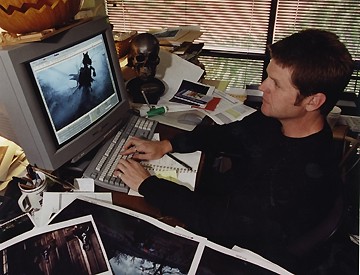

Early in the prep stage of Sleepy Hollow, the film's effects team attempted to create the Headless Horseman with the old "built-up shoulders" gag. However, the venerable trick distorts body proportions, turning the average actor into a towering headless hulk. When the filmmakers saw the results, they realized that the actor's head wasn't the only thing missing the effect also lacked realism.Director Tim Burton asked ILM's Jim Mitchell, who brought CG Martians to life in Mars Attacks!, to oversee Sleepy Hollow's visual effects. To minimize ILM's workload, Mitchell also initially lobbied to do the Headless Horseman the old-fashioned way. "But in the back of our minds," Mitchell admits, "Tim and I knew that something just wasn't going to be right with that approach. We eventually decided that our Headless Horseman would be an actual person riding the horse and flailing his axe around, except that we'd just digitally erase his head.
"In all honesty, Sleepy Hollow is not a big effects show like Mars Attacks!, where we were doing a lot of animation. The majority of our work was enhancing the visuals created by Tim, cinematographer Emmanuel Lubezki and production designer Rick Heinrichs, so we've done about eight matte paintings and a bunch of other effects. Our work is not there to draw attention to itself."
Mitchell divvied the Horseman shots between ILM and London's Computer Film Company, marking the first time an ILM effects artist has simultaneously supervised visual effects at another facility. "Of the 300-some Headless Horseman shots, we've done about 220, with CFC handling the rest," Mitchell says. "We were in London for seven months shooting all of this stuff, and as we got started on the effects, I was able to interact with CFC over there. [ILM animation supervisor] Mark Miller and I broke everything down into sequences so that we weren't intermixing shots in the same sequence. That way, their shots would have continuity and so would ours. Despite the distance between us, we actually created a consistent look. They did fine work."
Two actors played the Headless Horseman: Rob Inch performed in the riding sequences and daredevil shots, while Ray Park (of Darth Maul fame) handled the fighting sequences. Each wore a blue hood over his head to facilitate the digital removal, which was not as easy as it sounds especially since Lubezki's restless camera was forever prowling over sets filled with billowing fog. "On every shot involving the Horseman, we just let Tim and Emmanuel shoot the plate as if the head was already gone," Mitchell notes. "Forget the fact that we were going to be struggling to erase this blue head moving through the woods with fog surrounding it. There are all kinds of things we'd prefer to stay away from when we're doing this type of work, but if you lose those [atmospheric] touches, all of a sudden it's not the same sort of visual, and it doesn't have same power."
Once they removed the actors' heads from the picture, ILM and CFC's artists still had to reinstate the foggy backgrounds and other elements of the scenes. "We never shot anything with motion control, so there was a lot of 2-D tracking to match things up, and frame-by-frame paint work to replicate the backgrounds," Mitchell says. "The big problem for us was [that] every shot involving the Horseman also had lightning and fog, which was constantly moving and always changing, as opposed to trees and buildings, which are rigid. Whenever lightning hit the Horseman, we had to make sure that when we replaced his collar or any other parts of his suit that his head was blocking, we put the same lighting effect on it."
Equally tricky were fight scenes in which the faces of actors Johnny Depp or Casper Van Dien were blocked by the Horseman's blue hood. "Once we erased the Horseman's head, we also erased Johnny or Casper's face, and we had to replace that," Mitchell reveals. "I would have Johnny or Casper go through the same actions without the Horseman in there, and we'd just put their head into any frames where the Horseman's head was blocking theirs. It's a tricky process, but it was actually pretty effective."
The old prosthetic shoulder-and-neckpiece gag did come into play for a few Headless Horseman shots. Kevin Yagher, Sleepy Hollow's co-producer, co-writer and makeup effects supervisor, explains, "If the Horseman's coming straight at you, the guy's got his head [tilted] back, and there is a portion of the torso and shoulders that are built up to hide it. When they shot the reverse angle, we had a different piece where he was bending his head forward. We also did a torso that we used at one point a close-up in which Ichabod looks down into the horseman's 'neck hole' and sees a mass of worms and insects crawling around."